2014 Winter Olympic Games

Sochi 2014 Winter Olympics, Russia – Venue Preview – Unravel Travel TV
Sochi 2014 staged in Russia will be the most compact Winter Games in the history of the Olympic Movement. It will be possible to get from one venue to another in just a matter of minutes and all Olympic and Paralympic competition will take place in the same venues. It is for this reason that all athletic facilities for the Sochi 2014 Games are being built with the needs of disabled people in mind. Eleven athletic venues will be built for the Sochi 2014 Games, which will be divided into two clusters – mountain and coastal. The clusters will be located within 48km of each other, which is less than a 30 minute ride along a new railway. Each cluster will contain an Olympic Village. The travel time from the Olympic Village to a competition venue in the coastal cluster will be no more than five minutes. Additionally, travel time from the Olympic Village to a competition venue in the mountain cluster is less than 15 minutes. The central focus of the coastal cluster will be the Olympic Park. It will connect up all competition venues, the parking zone and the infrastructure elements. For the first time in the history of the Olympic and Paralympic Games, all ice arenas will be within walking distance of one other. The Olympic Park will be able to accommodate about 70,000 visitors when full. The Mountain Cluster will include Biathlon and Ski Complexes, a Bobsleigh Track, a Ski Center, a Ski Jump Complex, as well as a Snowboard Park and Freestyle Center. 5,500 Olympic athletes, 1,350 Paralympic athletes, 25,000 volunteers, and 13,000 members of the press will come to the Games in Sochi. Sports venues in the Olympic Park will be visited daily by more than 75,000 people, and the Games’ television audience will be approximately 3 billion viewers! In addition, residents of Russia’s major cities will be able to watch a live television broadcast of the Olympic events at specially equipped Olympic sites called Live Sites. The Live Sites will be traditional celebration sites in city centers which will be equipped with big screens, sound, light, and a stage for people to watch the Games together, experience the atmosphere, and celebrate the victories of Russian athletes. It is expected that a total of up to 30 million people will visit the Live Sites, so almost every family in Russia will be able to be part of the Games in Sochi.
The Winter Olympic Games is a major international sporting event that occurs once every four years. The first celebration of the Winter Olympics was held in Chamonix, France, in 1924. The original sports were alpine and cross-country skiing, figure skating, ice hockey, Nordic combined, ski jumping and speed skating. The Games were held every four years from 1924 until 1936, after which they were interrupted by World War II. The Olympics resumed in 1948 and were celebrated every four years. The Winter and Summer Olympic Games were held in the same years until 1992, after a 1986 decision by the International Olympic Committee (IOC) to place the Summer and Winter Games on separate four-year cycles in alternating even-numbered years. Because of the change, the next Winter Olympics after 1992 were in 1994.
The Winter Games have evolved since their inception. Sports have been added and some of them, such as luge, short track speed skating and freestyle skiing, have earned a permanent spot on the Olympic programme. Others, such as speed skiing, bandy and skijoring, were demonstration sports but never incorporated as Olympic sports. The rise of television as a global medium for communication enhanced the profile of the Games. It created an income stream, via the sale of broadcast rights and advertising, which has become lucrative for the IOC. This allowed outside interests, such as television companies and corporate sponsors, to exert influence. The IOC has had to address several criticisms, internal scandals, the use of performance enhancing drugs by Winter Olympians, as well as a political boycott of the Winter Olympics. Nations have used the Winter Games to showcase the claimed superiority of their political systems.
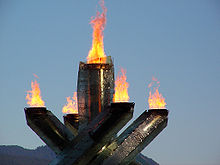 The Winter Olympics have been hosted on three continents, but never in a country in the southern hemisphere. The United States has hosted the Games four times; France has been the host three times; Austria, Canada, Japan, Italy, Norway and Switzerland have hosted the Games twice. In 2014 Sochi will be the first Russian city to host the Winter Olympics. The IOC has selected Pyeongchang, South Korea, to host the 2018 Winter Olympics.
The Winter Olympics have been hosted on three continents, but never in a country in the southern hemisphere. The United States has hosted the Games four times; France has been the host three times; Austria, Canada, Japan, Italy, Norway and Switzerland have hosted the Games twice. In 2014 Sochi will be the first Russian city to host the Winter Olympics. The IOC has selected Pyeongchang, South Korea, to host the 2018 Winter Olympics.
12 countries – Austria, Canada, Finland, France, Great Britain, Hungary, Italy, Norway, Poland, Sweden, Switzerland and the United States – have attended every Winter Olympic games. Six of those (Austria, Canada, Finland, Norway, Sweden and the United States) have earned medals at every Winter Olympic Games, and only one – the United States – has earned gold at each Games. Germany and Japan have been banned at times from competing in the Games.
History – Early Years
 Ulrich Salchow at the 1908 Olympics
Ulrich Salchow at the 1908 Olympics
The first international multi-sport event for winter sports was the Nordic Games held in Sweden in 1901. The idea was brought from the Deaflymic Winter Olympic. Originally organized by General Viktor Gustaf Balck, the Nordic Games were held again in 1903 and 1905 and then every fourth year thereafter until 1926. Balck was a charter member of the International Olympic Committee (IOC) and a close friend of Olympic Games founder Pierre de Coubertin. He attempted to have winter sports, specifically figure skating, added to the Olympic programme but was unsuccessful until the 1908 Summer Olympics in London, United Kingdom. Four figure skating events were contested and at which Ulrich Salchow (10-time world champion) and Madge Syers won the individual titles.
Three years later Italian count Eugenio Brunetta d’Usseaux proposed that the IOC stage a week of winter sports included as part of the 1912 Summer Olympics in Stockholm, Sweden. The organisers opposed this idea because they desired to protect the integrity of the Nordic Games and were concerned about a lack of facilities for winter sports. The idea was resurrected for the 1916 Games, which were to be held in Berlin, Germany. A winter sports week with speed skating, figure skating, ice hockey and Nordic skiing was planned, but the 1916 Olympics was cancelled after the outbreak of World War I.
The first Olympics after the war were held in Antwerp, Belgium and featured figure skating and ice hockey tournament. Germany, Austria, Hungary, Bulgaria and Turkey were banned from competing in the Games. At the IOC Congress held the following year it was decided that the host nation of the 1924 Summer Olympics, France, would host a separate “International Winter Sports Week” under the patronage of the IOC. Chamonix was chosen to host this “week” (actually 11 days) of events. The Games proved to be a success when more than 250 athletes from 16 nations competed in 16 events. Athletes from Finland and Norway won 28 medals, more than the rest of the participating nations combined. Germany remained banned until 1925, and instead hosted a series of games called Deutsche Kampfspiele, starting with the Winter edition of 1922 (which predated the first Winter Olympics). In 1925 the IOC decided to create a separate Olympic Winter Games and the 1924 Games in Chamonix was retroactively designated as the first Winter Olympics.
St. Moritz, Switzerland, was appointed by the IOC to host the second Olympic Winter Games in 1928. Fluctuating weather conditions challenged the hosts. The opening ceremony was held in a blizzard while warm weather conditions plagued sporting events throughout the rest of the Games. Because of the weather the 10,000 metre speed-skating event had to be abandoned and officially cancelled. The weather was not the only note-worthy aspect of the 1928 Games; Sonja Henie of Norway made history when she won the figure skating competition at the age of 15. She became the youngest Olympic champion in history, a distinction she would hold for 74 years.
The next Winter Olympics was the first to be hosted outside of Europe. Seventeen nations and 252 athletes participated. This was less than in 1928 as the journey to Lake Placid, United States, was a long and expensive one for most competitors who had little money in the midst of the Great Depression. The athletes competed in fourteen events in four sports. Virtually no snow fell for two months before the Games, and it was not until mid-January that there was enough snow to hold all the events. Sonja Henie defended her Olympic title and Eddie Eagan, who had been an Olympic champion in boxing in 1920, won the gold in the men’s bobsleigh event to become the first, and so far only, Olympian to have won gold medals in both the Summer and Winter Olympics.
The German towns of Garmisch and Partenkirchen joined to organise the 1936 edition of the Winter Games, held on 6–16 February. This would be the last time the Summer and Winter Olympics were held in the same country in the same year. Alpine skiing made its Olympic debut, but skiing teachers were barred from entering because they were considered to be professionals. Because of this decision the Swiss and Austrian skiers refused to compete at the Games.
World War II
World War II interrupted the celebrations of the Winter Olympics. The 1940 Games had been awarded to Sapporo, Japan, but the decision was rescinded in 1938 because of the Japanese invasion of China. The Games were moved to Garmisch-Partenkirchen, Germany, but the German invasion of Poland in 1939 forced the complete cancellation of the 1940 Games. Due to the ongoing war the 1944 Games, originally scheduled for Cortina D’Ampezzo, Italy, were cancelled.
1948 to 1960
St. Moritz was selected to host the first post-war Games in 1948. Switzerland’s neutrality had protected the town during World War II and most of the venues were in place from the 1928 Games, which made St. Moritz a logical choice to become the first city to host a Winter Olympics twice. Twenty-eight countries competed in Switzerland, but athletes from Germany and Japan were not invited. Controversy erupted when two hockey teams from the United States arrived, both claiming to be the legitimate U.S. Olympic hockey representative. The Olympic flag presented at the 1920 Summer Olympics in Antwerp was stolen, as was its replacement. There was unprecedented parity at these Games, during which 10 countries won gold medals—more than any Games to that point.
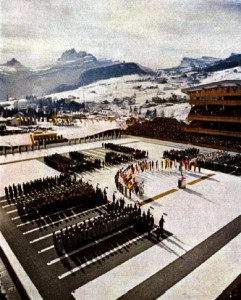 The opening ceremonies of the 1956 Winter Olympics in Cortina d’Ampezzo
The opening ceremonies of the 1956 Winter Olympics in Cortina d’Ampezzo
The Olympic Flame for the 1952 Games in Oslo, was lit in the fireplace by skiing pioneer Sondre Nordheim and the torch relay was conducted by 94 participants entirely on skis. Bandy, a popular sport in the Nordic countries, was featured as a demonstration sport; though only Norway,Sweden and Finland fielded teams. Norwegian athletes won 17 medals, which outpaced all the other nations. They were led by Hjalmar Andersen who won three gold medals in four events in the speed skating competition.
After not being able to host the Games in 1944, Cortina d’Ampezzo was selected to organise the 1956 Winter Olympics. At the opening ceremonies the final torch bearer, Guido Caroli, entered the Olympic Stadium on ice skates. As he skated around the stadium his skate caught on a cable and he fell, nearly extinguishing the flame. He was able to recover and light the cauldron. These were the first Winter Games to be televised, though no television rights would be sold until the 1960 Summer Olympics in Rome. The Cortina Games were used to test the feasibility of televising large sporting events. The Soviet Union made its Olympic debut and had an immediate impact, winning more medals than any other nation. Chiharu Igaya won the first Winter Olympics medal for Japan and the continent of Asia, when he placed second in the slalom.
The IOC awarded the 1960 Olympics to Squaw Valley, United States. Since the village was underdeveloped there was a rush to construct infrastructure and sports facilities like an ice arena, speed-skating track, and a ski-jump hill. The opening and closing ceremonies were produced by Walt Disney. The Squaw Valley Olympics had a number of notable firsts: it was the first Olympics to have a dedicated athletes’ village; it was the first to use a computer (courtesy of IBM) to tabulate results; and the first to feature female speed skating events. The bobsleigh events were absent for the only time because the organising committee found it too expensive to build the bobsleigh run.
1964 to 1980
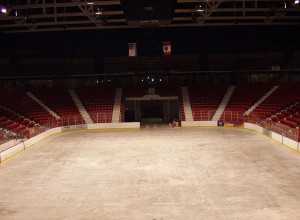 The Herb Brooks Arena, in Lake Placid (c.2007), site of the “Miracle on Ice” in 1980
The Herb Brooks Arena, in Lake Placid (c.2007), site of the “Miracle on Ice” in 1980
The Austrian city of Innsbruck was the host in 1964. Although Innsbruck was a traditional winter sports resort, warm weather caused a lack of snow during the Games and the Austrian army was asked to transport snow and ice to the sport venues. Soviet speed-skater Lidia Skoblikova made history by sweeping all four speed-skating events. Her career total of six gold medals set a record for Winter Olympics athletes. Luge was first contested in 1964, although the sport received bad publicity when a competitor was killed in a pre-Olympic training run.
Held in the French town of Grenoble, the 1968 Winter Olympics were the first Olympic Games to be broadcast in colour. There were 37 nations and 1,158 athletes competing in 35 events. Frenchman Jean-Claude Killy became only the second person to win all the men’s alpine skiing events. The organising committee sold television rights for $2 million, which was more than double the price of the broadcast rights for the Innsbruck Games. Venues were spread over long distances requiring three athletes’ villages. The organisers claimed this was required to accommodate technological advances. Critics disputed this, alleging that the layout was necessary to provide the best possible venues for television broadcasts at the expense of the athletes.
The 1972 Winter Games, held in Sapporo, Japan, were the first to be hosted outside North America or Europe. The issue of professionalism became contentious during the Sapporo Games. Three days before the Games IOC president Avery Brundagethreatened to bar a number of alpine skiers from competing because they participated in a ski camp at Mammoth Mountain in the United States. Brundage reasoned that the skiers had financially benefited from their status as athletes and were therefore no longer amateurs. Eventually only Austrian Karl Schranz, who earned more than all the other skiers, was not allowed to compete. Canada did not send teams to the 1972 or 1976 ice hockey tournaments in protest of their inability to use players from professional leagues. Francisco Fernández Ochoa became the first (and only) Spaniard to win a Winter Olympic gold medal; he triumphed in the slalom.
The 1976 Winter Olympics had been awarded in 1970 to Denver, United States, but in November 1972 the voters of the state of Colorado voted against public funding of the games by a 3 to 2 margin. Innsbruck, which had maintained most of the infrastructure from the 1964 Games, was chosen in February 1973 to replace Denver. Two Olympic flames were lit because it was the second time the Austrian town had hosted the Games. The 1976 Games featured the first combination bobsleigh and luge track, in neighbouring Igls. The Soviet Union won its fourth consecutive ice hockey gold medal.
In 1980 the Olympics returned to Lake Placid, which had hosted the 1932 Games. The first boycott of a Winter Olympics occurred in 1980 when Taiwan refused to participate after an edict by the IOC mandated that they change their name and national anthem. The IOC was attempting to accommodate China, who wished to compete using the same name and anthem that had been used by Taiwan. American speed-skater Eric Heiden set either an Olympic or world record in each of the five events he competed in. Hanni Wenzel won both the slalom and giant slalom and her country, Liechtenstein, became the smallest nation to produce an Olympic gold medallist. In the “Miracle on Ice” the American hockey team beat the favoured Soviets and went on to win the gold medal.
1984 to 1998
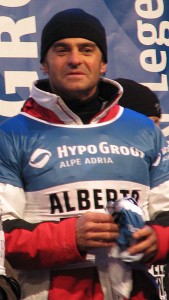 Alberto Tomba, winner of five Olympic medals in Calgary, Albertville, and Lillehammer
Alberto Tomba, winner of five Olympic medals in Calgary, Albertville, and Lillehammer
Sapporo, Japan and Gothenburg, Sweden, were front-runners to host the 1984 Winter Olympics. It was therefore a surprise when Sarajevo, Yugoslavia, was selected as host. The Games were well-organised and displayed no indication of the war that would engulf the country eight years later. A total of 49 nations and 1,272 athletes participated in 39 events. Host nation Yugoslavia won its first Olympic medal when alpine skier Jure Franko won a silver in the giant slalom. Another sporting highlight was the free dance performance of British ice dancers Jayne Torvill and Christopher Dean. Their performance to Ravel‘s Boléro earned the pair the gold medal after achieving unanimous perfect scores for artistic impression.
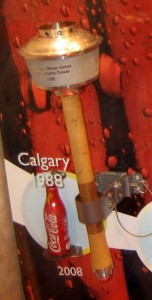 The Olympic Torch from the 1988 Winter Olympic Games in Calgary
The Olympic Torch from the 1988 Winter Olympic Games in Calgary
In 1988, the Canadian city of Calgary hosted the first Winter Olympics to span 16 days. New events were added in ski-jumping and speed skating; while future Olympic sports curling, short track speed skating and freestyle skiing made their appearance as demonstration sports. For the first time the speed skating events were held indoors, on the Olympic Oval. Dutch skater Yvonne van Gennip won three gold medals and set two world records, beating skaters from the favoured East German team in every race. Her medal total was equalled by Finnish ski jumper Matti Nykänen, who won all three events in his sport. Alberto Tomba, anItalian skier, made his Olympic debut by winning both the giant slalom and slalom. East German Christa Rothenburger won the women’s 1,000 metre speed skating event. Seven months later she would earn a silver in track cycling at the Summer Games in Seoul, to become the only athlete to win medals in both a Summer and Winter Olympics in the same year.
The 1992 Games were the last to be held in the same year as the Summer Games. They were hosted in the French Savoie region in the city of Albertville, though only 18 events were held in the city. The rest of the events were spread out over the Savoie. Political changes of the time were reflected in the Olympic teams appearing in France: this was the first Games to be held after the fall of Communism and the dismantling of the Berlin Wall and Germany competed as a single nation for the first time since the 1964 Games; former Yugoslavian republics Croatia and Slovenia made their debuts as independent nations; most of the former Soviet republics still competed as a single team known as the Unified Team, but the Baltic States made independent appearances for the first time since before World War II. At 16 years old, Finnish ski jumper Toni Nieminen made history by becoming the youngest male Winter Olympic champion. New Zealand skier Annelise Coberger became the first Winter Olympic medallist from the southern hemisphere when she won a silver medal in the women’s slalom.
In 1986 the IOC had voted to separate the Summer and Winter Games and place them in alternating even-numbered years. This change became effective for the 1994 Games, held in Lillehammer, Norway, which became the first Winter Olympics to be held separate from the Summer Games. After the division of Czechoslovakia in 1993 the Czech Republic and Slovakia made their Olympic debuts. The women’s figure skating competition garnered media attention when American skater Nancy Kerrigan was injured on 6 January 1994, in an assault planned by the ex-husband of opponent Tonya Harding. Both skaters competed in the Games, but the gold medal was won by Oksana Baiul. She became Ukraine’s first Olympic champion. Johann Olav Koss of Norway won three gold medals coming first in all of the distance speed skating events.
The 1998 Winter Olympics were held in the Japanese city of Nagano and were the first Games to host more than 2,000 athletes. The men’s ice hockey tournament was opened to professionals for the first time. Canada and the United States, with their many NHLplayers, were favoured to win the tournament. Neither won any hockey medals however, as the Czech Republic prevailed. Women’s ice hockey made its debut and the United States won the gold medal. Bjørn Dæhlie of Norway won three gold medals in Nordic skiing. He became the most decorated Winter Olympic athlete with eight gold medals and twelve medals overall. AustrianHermann Maier survived a crash during the downhill competition and returned to win gold in the super-g and the giant slalom. A wave of new world records were set in speed skating because of the introduction of the clap skate.


